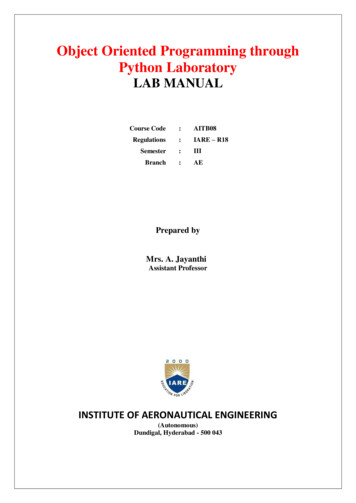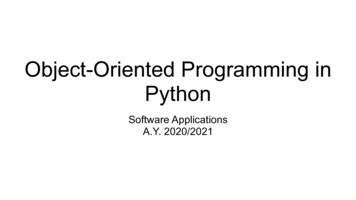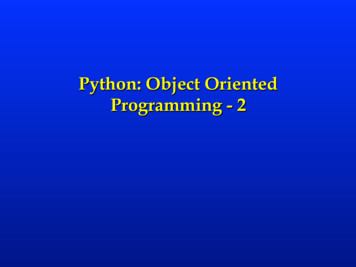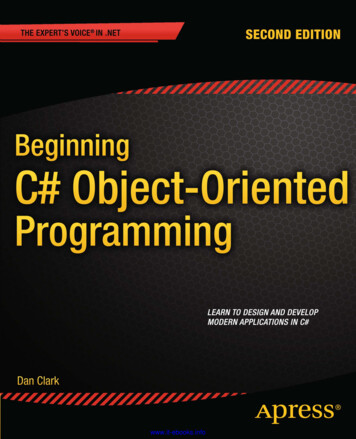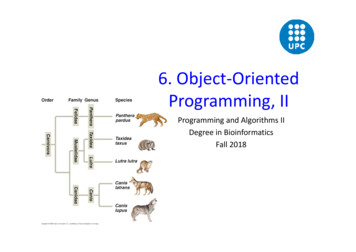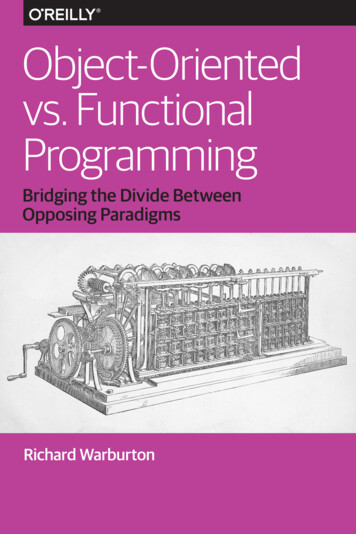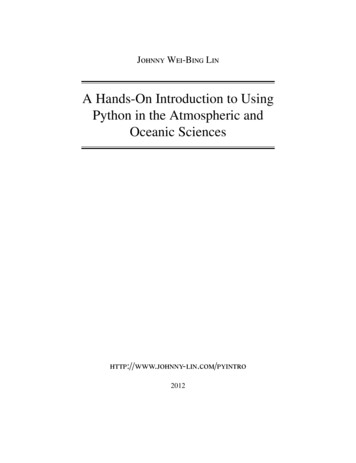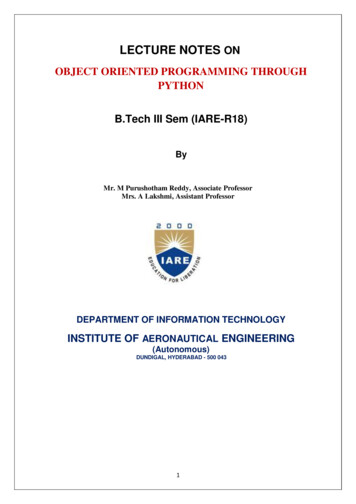
Transcription
LECTURE NOTES ONOBJECT ORIENTED PROGRAMMING THROUGHPYTHONB.Tech III Sem (IARE-R18)ByMr. M Purushotham Reddy, Associate ProfessorMrs. A Lakshmi, Assistant ProfessorDEPARTMENT OF INFORMATION TECHNOLOGYINSTITUTE OF AERONAUTICAL ENGINEERING(Autonomous)DUNDIGAL, HYDERABAD - 500 0431
Module-IIntroduction to Python and Object Oriented ConceptsIntroduction to PythonProgramming languages like C, Pascal or FORTRAN concentrate more on the functional aspects ofprogramming. In these languages, there will be more focus on writing the code using functions. Forexample, we can imagine a C program as a combination of several functions. Computer scientiststhought that programming will become easy for human beings to understand if it is based on real lifeexamples.Hence, they developed Object Oriented Programming languages like Java and .NET whereprogramming is done through classes and objects. Programmers started migrating from C to Java andJava soon became the most popular language in the software community. In Java, a programmershould express his logic through classes and objects only. It is not possible to write a program withoutwriting at least one class! This makes programming lengthy.For example, a simple program to add two numbers in Java looks like this://Java program to add two numbersclass Add //create a class{public static void main(String args[]) //start execution{int a, b; //take two variablesa b 10; //store 10 in to a, bSystem.out.println("Sum " (a b)); //display their sum}}PythonPython is a programming language that combines the features of C and Java. It offers elegant style ofdeveloping programs like C. When the programmers want to go for object orientation, Python offersclasses and objects like Java. In Python, the program to add two numbers will be as follows:#Python program to add two numbersa b 10 #take two variables and store 10 in to themprint("Sum ", (a b)) #display their sum2
Van Rossum picked the name Python for the new language from the TV show, Monty Python‘sFlying Circus. Python‘s first working version was ready by early 1990 and Van Rossum released it forthe public on February 20, 1991. The logo of Python shows two intertwined snakes as shown inFigure 1.1.Python is open source software, which means anybody can freely download it from www.python.organd use it to develop programs. Its source code can be accessed and modified as required in theprojects.Features of PythonThere are various reasons why Python is gaining good popularity in the programming community.The following are some of the important features of Python:1. Simple: Python is a simple programming language. When we read a Python program, we feellike reading English sentences. It means more clarity and less stress on understanding thesyntax of the language. Hence, developing and understanding programs will become easy.2. Easy to learn: Python uses very few keywords. Its programs use very simple structure. So,developing programs in Python become easy. Also, Python resembles C language. Most ofthe language constructs in C are also available in Python. Hence, migrating from C to Pythonis easy for programmers.3. Open source: There is no need to pay for Python software. Python can be freely downloadedfrom www.python.org website. Its source code can be read, modified and can be used inprograms as desired by the programmers.4. High level language: Programming languages are of two types: low level and high level. Alow level language uses machine code instructions to develop programs. These instructionsdirectly interact with the CPU. Machine language and assembly language are called low levellanguages. High level languages use English words to develop programs. These are easy tolearn and use. Like COBOL, PHP or Java, Python also uses English words in its programsand hence it is called high level programming language.5. Dynamically typed: In Python, we need not declare anything. An assignment statementbinds a name to an object, and the object can be of any type. If a name is assigned to anobject of one type, it may later be assigned to an object of a different type. This is themeaning of the saying that Python is a dynamically typed language. Languages like C andJava are statically typed. In these languages, the variable names and data types should bementioned properly. Attempting to assign an object of the wrong type to a variable nametriggers error or exception.3
6. Platform independent: When a Python program is compiled using a Python compiler, itgenerates byte code. Python‘s byte code represents a fixed set of instructions that run on alloperating systems and hardware. Using a Python Virtual Machine (PVM), anybody can runthese byte code instructions on any computer system. Hence, Python programs are notdependent on any specific operating system. We can use Python on almost all operatingsystems like UNIX, Linux, Windows,Macintosh, Solaris, OS/2, Amiga, AROS, AS/400, etc.This makes Python an ideal programming language for any network or Internet.7. Portable: When a program yields the same result on any computer in the world, then it iscalled a portable program. Python programs will give the same result since they are platformindependent. Once a Python program is written, it can run on any computer system usingPVM. However, Python also contains some system dependent modules (or code), which arespecific to operating system. Programmers should be careful about such code whiledeveloping the software if they want it to be completely portable.8. Procedure and object oriented: Python is a procedure oriented as well as an object orientedprogramming language. In procedure oriented programming languages (e.g. C and Pascal),the programs are built using functions and procedures. But in object oriented languages (e.g.C and Java), the programs use classes and objects.Let‘s get some idea on objects and classes. An object is anything that exists physically in the realworld. Almost everything comes in this definition. Let‘s take a dog with the name Snoopy. We cansay Snoopy is an object since it physically exists in our house. Objects will have behavior representedby their attributes (or properties) and actions. For example, Snoopy has attributes like height, weight,age and color. These attributes are represented by variables in programming. Similarly, Snoopy canperform actions like barking, biting, eating, running, etc. These actions are represented by methods(functions) in programming. Hence, an object contains variables and methods.A class, on the other hand, does not exist physically. A class is only an abstract idea which representscommon behavior of several objects. For example, dog is a class. When we talk about dog, we willhave a picture in our mind where we imagine a head, body, legs, tail, etc. This imaginary picture iscalled a class. When we take Snoopy, she has all the features that we have in our mind but she existsphysically and hence she becomes the object of dog class. Similarly all the other dogs like Tommy,Charlie, Sophie, etc. exhibit same behavior like Snoopy. Hence, they are all objects of the same class,i.e. dog class. We should understand the point that the object Snoopy exists physically but the classdog does not exist physically. It is only a picture in our mind with some attributes and actions atabstract level. When we take Snoopy, Tommy, Charlie and Sophie, they have these attributes andactions and hence they are all objects of the dog class.A class indicates common behavior of objects. This common behavior is represented by attributes andactions. Attributes are represented by variables and actions are performed by methods (functions). So,a class also contains variables and methods just like an object does. Figure 1.2 shows relationshipbetween a class and its object:4
Fig: A Class and its objectSimilarly, parrot, sparrow, pigeon and crow are objects of the bird class. We should understand thatbird (class) is only an idea that defines some attributes and actions. A parrot and sparrow have thesame attributes and actions but they exist physically. Hence, they are objects of the bird class.Object oriented languages like Python, Java and .NET use the concepts of classes and objects in theirprograms. Since class does not exist physically, there will not be any memory allocated when theclass is created. But, object exists physically and hence, a separate block of memory is allocated whenan object is created. In Python language, everything like variables, lists, functions, arrays etc. aretreated as objects.a. Interpreted: A program code is called source code. After writing a Python program, we shouldcompile the source code using Python compiler. Python compiler translates the Pythonprogram into an intermediate code called byte code. This byte code is then executed by PVM.Inside the PVM, an interpreter converts the byte code instructions into machine code so thatthe processor will understand and run that machine code to produce results.b. Extensible: The programs or pieces of code written in C or C can be integrated into Pythonand executed using PVM. This is what we see in standard Python that is downloaded fromwww.python.org. There are other flavors of Python where programs from other languages canbe integrated into Python. For example, Jython is useful to integrate Java code into Pythonprograms and run on JVM (Java Virtual Machine). Similarly, Iron Python is useful tointegrate .NET programs and libraries into Python programs and run on CLR (CommonLanguage Runtime).c. Embeddable: We can insert Python programs into a C or C program. Several applicationsare already developed in Python which can be integrated into other programming languageslike C, C , Delphi, PHP, Java and .NET. It means programmers can use these applicationsfor their advantage in various software projects.5
d. Huge library: Python has a big library which can be used on any operating system like UNIX,Windows or Macintosh. Programmers can develop programs very easily using the modulesavailable in the Python library.e. Scripting language: A scripting language is a programming language that does not use acompiler for executing the source code. Rather, it uses an interpreter to translate the sourcecode into machine code on the fly (while running). Generally, scripting languages performsupporting tasks for a bigger application or software. For example, PHP is a scriptinglanguage that performs supporting task of taking input from an HTML page and send it toWeb server software. Python is considered as a scripting language as it is interpreted and it isused on the Internet to support other software.f. Database connectivity: A database represents software that stores and manipulates data. Forexample, Oracle is a popular database using which we can store data in the form of tables andmanipulate the data. Python provides interfaces to connect its programs to all major databaseslike Oracle, Sybase or MySql.g. Scalable: A program would be scalable if it could be moved to another operating system orhardware and take full advantage of the new environment in terms of performance. Pythonprograms are scalable since they can run on any platform and use the features of the newplatform effectively.h. Batteries included: The huge library of Python contains several small applications (or smallpackages) which are already developed and immediately available to programmers. Thesesmall packages can be used and maintained easily. Thus the programmers need not downloadseparate packages or applications in many cases. This will give them a head start in manyprojects. These libraries are called ‗batteries included‘.Some interesting batteries or packages are given here:1. botois Amazon web services library2. cryptography offers cryptographic techniques for the programmers3. Fiona reads and writes big data files4. jellyfish is a library for doing approximate and phonetic matching of strings5. mysql-connector-pythonis a driver written in Python to connect to MySQL database6. numpy is a package for processing arrays of single or multidimensional type7. pandas is a package for powerful data structures for data analysis, time series and statistics8. matplotlib is a package for drawing electronic circuits and 2D graphs.9. pyquery represents jquery-like library for Python10. w3lib is a library of web related functions6
Data types in PythonWe have already written a Python program to add two numbers and executed it. Let‘s now view theprogram once again here:#First Python program to add two numbersa 10b 15c a bprint("Sum ", c)When we compile this program using Python compiler, it converts the program source code into bytecode instructions. This byte code is then converted into machine code by the interpreter inside thePython Virtual Machine (PVM). Finally, the machine code is executed by the processor in ourcomputer and the result is produced as:F:\PY python first.pySum 25Observe the first line in the program. It starts with the #symbol. This is called the comment line. Acomment is used to describe the features of a program. When we write a program, we may write somestatements or create functions or classes, etc. in our program. All these things should be describedusing comments. When comments are written, not only our selves but also any programmer can easilyunderstand our program. It means comments increase readability (understandability) of our programs.Comments in PythonThere are two types of comments in Python: single line comments and multi line comments. Singleline comments .These comments start with a hash symbol (#) and are useful to mention that the entireline till the end should be treated as comment. For example,#To find sum of two numbersa 10 #store 10 into variable aHere, the first line is starting with a #and hence the entire line is treated as a comment. In the secondline, a 10 is a statement. After this statement, #symbol starts the comment describing that the value10 is stored into variable ‗a‘. The part of this line starting from #symbol to the end is treated as acomment. Comments are non-executable statements. It means neither the Python compiler nor thePVM will execute them.Multi line commentsWhen we want to mark several lines as comment, then writing #symbol in the beginning of every linewill be a tedious job. For example,#This is a program to find net salary of an employee#based on the basic salary, provident fund, house rent allowance,7
#dearness allowance and income tax.Instead of starting every line with #symbol, we can write the previous block of code inside """ (tripledouble quotes) or ''' (triple single quotes) in the beginning and ending of the block as:""" This is a program to find net salary of an employee based on the basic salary, provident fund,house rent allowance, dearness allowance and income tax. """The triple double quotes (""") or triple single quotes (''') are called ‗multi line comments‘ or ‗blockcomments‘. They are used to enclose a block of lines as comments.Data types in PythonA data type represents the type of data stored into a variable or memory. The data types which arealready available in Python language are called Built-in data types. The data types which can becreated by the programmers are called User-defined data types. The built-in data types are of fivetypes:1. None Type2. Numeric types3. Sequences4. Sets5. MappingsNone TypeIn Python, the ‗None‘ data type represents an object that does not contain any value. In languages likeJava, it is called ‗null‘ object. But in Python, it is called ‗None‘ object. In a Python program,maximum of only one ‗None‘ object is provided. One of the uses of ‗None‘ is that it is used inside afunction as a default value of the arguments. When calling the function, if no value is passed, then thedefault value will be taken as ‗None‘. If some value is passed to the function, then that value is usedby the function. In Boolean expressions, ‗None‘ data type represents ‗False‘.Numeric TypesThe numeric types represent numbers. There are three sub types: int float complexInt Data typeThe int data type represents an integer number. An integer number is a number without any decimalpoint or fraction part. For example, 200, -50, 0, 9888998700, etc. are treated as integer numbers. Now,let‘s store an integer number -57 into a variable ‗a‘.a -578
Here, ‗a‘ is called int type variable since it is storing -57 which is an integer value. In Python, there isno limit for the size of an int data type. It can store very large integer numbers conveniently.Float Data typeThe float data type represents floating point numbers. A floating point number is a number thatcontains a decimal point. For example, 0.5, -3.4567, 290.08, 0.001 etc. are called floating pointnumbers. Let‘s store a float number into a variable ‗num‘ as:num 55.67998Here num is called float type variable since it is storing floating point value. Floating point numberscan also be written in scientific notation where we use ‗e‘ or ‗E‘ to represent the power of 10. Here ‗e‘or ‗E‘ represents ‗exponentiation‘. For example, the number 2.5 104 is written as 2.5E4. Suchnumbers are also treated as floating point numbers. For example,x 22.55e3Here, the float value 22.55 103 is stored into the variable ‗x‘. The type of the variable ‗x‘ will beinternally taken as float type. The convenience in scientific notation is that it is possible to representvery big numbers using less memory.Complex Data typeA complex number is a number that is written in the form of a bj or a bJ. Here, ‗a‘ represents thereal part of the number and ‗b‘ represents the imaginary part of the number. The suffix ‗j‘ or ‗J‘ after‗b‘ indicates the square root value of -1. The parts ‗a‘ and ‗b‘ may contain integers or floats. Forexample, 3 5j, -1-5.5J, 0.2 10.5J are all complex numbers. See the following statement:c1 -1-5.5JRepresenting Binary, Octal and Hexadecimal NumbersA binary number should be written by prefixing 0b (zero and b) or 0B (zero and B) before the value.For example, 0b110110, 0B101010011 are treated as binary numbers. Hexadecimal numbers arewritten by prefixing 0x (zero and x) or 0X (zero and big X) before the value, as 0xA180 or 0X11fb91etc. Similarly, octal numbers are indicated by prefixing 0o (zero and small o) or 0O (zero and then O)before the actual value. For example, 0O145 or 0o773 are octal values. Converting the Data typesExplicitly Depending on the type of data, Python internally assumes the data type for the variable. Butsometimes, the programmer wants to convert one data type into another type on his own. This iscalled type conversion or coercion. This is possible by mentioning the data type with parentheses. Forexample, to convert a number into integer type, we can write int(num).int(x) is used to convert the number x into int type. See the example:x 15.56int(x) #will display 15float(x) is used to convert x into float type.9
For example,num 15 float(num) #will display 15.0Bool Data typeThe bool data type in Python represents boolean values. There are only two boolean values True orFalse that can be represented by this data type. Python internally represents True as 1 and False as 0.A blank string like "" is also represented as False. Conditions will be evaluated internally to eitherTrue or False. For example,a 10b 20if(a b):print("Hello") #displays Hello.In the previous code, the condition a b which is written after if - is evaluated to True and hence it willexecute print("Hello").a 10 5 #here ‗a‘ is treated as bool type variableprint(a) #displays Truea 5 10print(a) #displays FalseTrue True will display 2 #True is 1 and false is 0True-False will display 1Sequences in PythonGenerally, a sequence represents a group of elements or items. For example, a group of integernumbers will form a sequence. There are six types of sequences in Python:1. str2. bytes3. bytearray4. list5. tuple6. rangeStr Data typeIn Python, str represents string data type. A string is represented by a group of characters. Strings areenclosed in single quotes or double quotes. Both are valid.10
str ―Welcome‖ #here str is name of string type variableWe can also write strings inside """ (triple double quotes) or ''' (triple single quotes) to span a group oflines including spaces.Bytes Data typeThe bytes data type represents a group of byte numbers just like an array does. A byte number is anypositive integer from 0 to 255 (inclusive). bytes array can store numbers in the range from 0 to 255and it cannot even store negative numbers. For example,elements [10, 20, 0, 40, 15] #this is a list of byte numbersx bytes(elements) #convert the list into bytes arrayprint(x[0]) #display 0th element, i.e 10We cannot modify or edit any element in the bytes type array. For example, x[0] 55 gives an error.Here we are trying to replace 0th element (i.e. 10) by 55 which is not allowed.Bytearray Data typeThe bytearray data type is similar to bytes data type. The difference is that the bytes type array cannotbe modified but the bytearray type array can be modified. It means any element or all the elements ofthe bytearray type can be modified. To create a bytearray type array, we can use the functionbytearray as:elements [10, 20, 0, 40, 15] #this is a list of byte numbersx bytearray(elements) #convert the list into bytearray type arrayprint(x[0]) #display 0th element, i.e 10We can modify or edit the elements of the bytearray. For example, we can write: x[0] 88 #replace0th element by 88 x[1] 99 #replace 1st element by 99.List Data typeLists in Python are similar to arrays in C or Java. A list represents a group of elements. The maindifference between a list and an array is that a list can store different types of elements but an arraycan store only one type of elements. Also, lists can grow dynamically in memory. But the size ofarrays is fixed and they cannot grow at runtime. Lists are represented using square brackets [] and theelements are written in [], separated by commas. For example,list [10, -20, 15.5, 'Vijay', "Mary"]will create a list with different types of elements. The slicing operation like [0: 3] represents elementsfrom 0th to 2nd positions, i.e. 10, 20, 15.5.Tuple Data typeA tuple is similar to a list. A tuple contains a group of elements which can be of different types. Theelements in the tuple are separated by commas and enclosed in parentheses (). Whereas the list11
elements can be modified, it is not possible to modify the tuple elements. That means a tuple can betreated as a read-only list. Let‘s create a tuple as:tpl (10, -20, 15.5, 'Vijay', "Mary")The individual elements of the tuple can be referenced using square braces as tpl[0], tpl[1], tpl[2], Now, if we try to modify the 0th element as:tpl[0] 99This will result in error. The slicing operations which can be done on lists are also valid in tuples.Range Data typeThe range data type represents a sequence of numbers. The numbers in the range are not modifiable.Generally, range is used for repeating a for loop for a specific number of times. To create a range ofnumbers, we can simply write:r range(10)Here, the range object is created with the numbers starting from 0 to 9.SetsA set is an unordered collection of elements much like a set in Mathematics. The order of elements isnot maintained in the sets. It means the elements may not appear in the same order as they are enteredinto the set. Moreover, a set does not accept duplicate elements. There are two sub types in sets: set data type frozenset data typeSet Data typeTo create a set, we should enter the elements separated by commas inside curly braces {}.s {10, 20, 30, 20, 50}print(s) #may display {50, 10, 20, 30}Please observe that the set ‗s‘ is not maintaining the order of the elements. We entered the elements inthe order 10, 20, 30, 20 and 50. But it is showing another order. Also, we repeated the element 20 inthe set, but it has stored only one 20. We can use the set() function to create a set as:ch set("Hello")print(ch) #may display {'H', 'e', 'l', 'o'}Here, a set ‗ch‘ is created with the characters H,e,l,o. Since a set does not store duplicate elements, itwill not store the second ‗l‘.12
frozenset Data typeThe frozenset data type is same as the set data type. The main difference is that the elements in the setdata type can be modified; whereas, the elements of frozenset cannot be modified. We can create afrozenset by passing a set to frozenset() function as:s {50,60,70,80,90}print(s) #may display {80, 90, 50, 60, 70}fs frozenset(s) #create frozenset fsprint(fs) #may display frozenset({80, 90, 50, 60, 70})Mapping TypesA map represents a group of elements in the form of key value pairs so that when the key is given, wecan retrieve the value associated with it. The dict datatype is an example for a map. The ‗dict‘represents a ‗dictionary‘ that contains pairs of elements such that the first element represents the keyand the next one becomes its value. The key and its value should be separated by a colon (:) and everypair should be separated by a comma. All the elements should be enclosed inside curly brackets {}.We can create a dictionary by typing the roll numbers and names of students. Here, roll numbers arekeys and names will become values. We write these key value pairs inside curly braces as:d {10: 'Kamal', 11: 'Pranav', 12: 'Hasini', 13: 'Anup', 14: 'Reethu'}Here, d is the name of the dictionary. 10 is the key and its associated value is ‗Kamal‘.The next key is 11 and its value is ‗Pranav‘. Similarly 12 is the key and ‗Hasini‘ is it value. 13 is thekey and ‗Anup‘ is the value and 14 is the key and ‗Reethu‘ is the value. We can create an emptydictionary without any elements as:d {}Literals in PythonA literal is a constant value that is stored into a variable in a program. Observe the followingstatement:a 15Here, ‗a‘ is the variable into which the constant value ‗15‘ is stored. Hence, the value 15 is called‗literal‘. Since 15 indicates integer value, it is called ‗integer literal‘. The following are different typesof literals in Python.1. Numeric literals2. Boolean literals3. String literals13
Numeric LiteralsExamplesLiteral name450, -15Integer literal3.14286, -10.6, 1.25E4Float literalThese literals represent numbers. Please observe the different types of numeric literals available inPython.Boolean LiteralsBoolean literals are the True or False values stored into a bool type variable.String LiteralsA group of characters is called a string literal. These string literals are enclosed in single quotes (') ordouble quotes (") or triple quotes ('''or"""). In Python, there is no difference between single quotedstrings and double quoted strings. Single or double quoted strings should end in the same line as:s1 'This is first Indian book's2 "Core Python"User-defined Data typesThe data types which are created by the programmers are called ‗user-defined‘ data types. Forexample, an array, a class, or a module is user-defined data types.Constants in PythonA constant is similar to a variable but its value cannot be modified or changed in the course of theprogram execution. We know that the variable value can be changed whenever required. But that isnot possible for a constant. Once defined, a constant cannot allow changing its value. For example, inMathematics, ‗pi‘ value is 22/7 which never changes and hence it is a constant. In languages like Cand Java, defining constants is possible. But in Python, that is not possible. A programmer canindicate a variable as constant by writing its name in all capital letters. For example, MAX VALUEis a constant. But its value can be changed.Identifiers and Reserved wordsAn identifier is a name that is given to a variable or function or class etc. Identifiers can includeletters, numbers, and the underscore character ( ). They should always start with a nonnumericcharacter. Special symbols such as?, #, ,%, and @ are not allowed in identifiers. Some examples foridentifiers are salary, name11, gross income, etc. We should also remember that Python is a casesensitive programming language. It means capital letters and small letters are identified separately byPython. For example, the names ‗num‘ and ‗Num‘ are treated as different names and hence representdifferent variables. Figure 3.12 shows examples of a variable, an operator and a literal:14
Reserved words are the words that are already reserved for some particular purpose in the Pythonlanguage. The names of these reserved words should not be used as identifiers. The following are thereserved words available in Python:Naming Conventions in PythonPython developers made some suggestions to the programmers regarding how to write names in theprograms. The rules related to writing names of packages, modules, classes, variables, etc. are callednaming conventions. The following naming conventions should be followed:1. Packages: Package names should be written in all lower case letters. When multiple words areused for a name, we should separate them using an underscore ( ).2. Modules: Modules names should be written in all lower case letters. When multiple words areused for a name, we should separate them using an underscore ( ).3. Classes: Each word of a class name should start with a capital letter. This rule is applicable forthe classes created by us. Python‘s built-in class names use all lowercase words. When a classrepresents exception, then its name should end with a word ‗Error‘.15
4. Global variables or Module-level variables: Global variables names should be all lower caseletters. When multiple words are used for a name, we should separate them using anunderscore ( ).5. Instance variables: Instance variables names should be all lower case letters. When multiplewords are used for a name, we should separate them using an underscore ( ). Non-publicinstance variable name should begin with an underscore.6. Function
Procedure and object oriented: Python is a procedure oriented as well as an object oriented programming language. In procedure oriented programming languages (e.g. C and Pascal), the programs are built using functions and procedures. But in object oriented languages (
